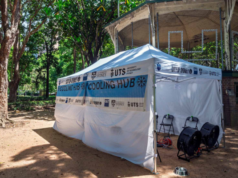A National Urban Policy to upgrade Australian suburbs through precinct level projects is one of the features of infrastructure spending in the 2023 Federal Budget.
The Budget, announced by Treasurer Jim Chalmers on May 9, earmarks $160 million over four years to establish an Urban Precincts and Partnerships Program under the National Urban Policy.
The program would “support transformative investment” based on the principles of “unifying urban places, growing economies and serving communities.”
A new Cities and Suburbs Unit will also be funded with $211.7 million to create new community and economic infrastructure in suburbs.
The initiatives have been welcomed by environmental, community and local government organisations such as the National Growth Areas Alliance (NGAA), which represents local government authorities in fast growing outer urban areas.
The NGAA welcomed the funding, saying it addressed the urgent need for sustainable urban development and showed a positive commitment to partnerships between the national and local governments.
“In particular NGAA welcomes the Thriving Suburbs Program for community infrastructure in suburban communities,” the NGAA said in a statement.
“Outer urban growth areas suffer significant deficits in the community facilities which other urban areas enjoy, with sports and recreation facilities, community centres and green open space either missing completely or delivered decades after residents have moved in.”
In the budget papers, the Government said the Thriving Suburbs Program would be funded with $200 million over two years from 2024-25 to “provide merit based and locally driven grants that address shortfalls in priority community infrastructure.”
The budget included a number of other initiatives in what the Government said would “strengthen Australia’s $120 billion ten year infrastructure pipeline.”
Minister for Infrastructure, Transport, Regional Development and Local Government Catherine King announced an independent 90 day independent review of the Infrastructure Investment Program.
The Minister said the number of infrastructure projects in the pipeline had “blown out” from 150 to around 800, and there were risks that some projects were without “adequate funding, resources or genuine commitment.”
The review will be undertaken by Clare Gardiner-Barnes, who was appointed to the board of Infrastructure Australia last year, along with Reece Waldock and Mike Mrdak.
Waldock most recently served as Director-General of the WA Department of Transport and Commissioner of Main Roads WA.
Mrdak has had a long career in infrastructure and asset management and is currently on the boards of NEC Australia, EnergyCo, Northern Territory Airports and the NSW Regional Growth Corporation.
In terms of additional funding, the budget allocated additional funding of $200 million to replenish the Major Projects Business Case Fund (MPBCF).
The fund is for the development of business cases with the aim of engaging the planning of strategically significant projects at an early point, “and ensuring the broader Commonwealth objectives are considered as projects are developed.”
The budget also locks in Federal support for the 2032 Brisbane Olympic and Paralympic Games, with a commitment of $2.5 billion for the Brisbane Area development and up to $935 million for 16 new or upgraded venues in partnership with the Queensland Government.
There is also $240 million to support development at Macquarie Point in Hobart, specifically for a broader urban renewal precinct, including the construction of affordable housing and a contribution to the Macquarie Point Stadium.
Another $65 million is earmarked for upgrades to UTAS Stadium in Launceston.
The budget also commits the Government to Vision Zero, the goal of zero deaths and serious injury due to road accidents by 2050.
As part of the National Safety Strategy, the budget allocates funding to maintain the $110 million Black Spot Program in collaboration with state, territory and local governments.
Another $43.6 million has been allocated for the new Nation Road Safety Action Grants Program over four years from 2022-23.
This program provides non-infrastructure grants to help implement the National Road Safety Action Plan with a focus on First Nations road safety, vulnerable road users, community education, technology, innovation, research and data.
Over $975 million will be available for the continual delivery of road safety improvements through the Road Safety Program, building on the more than 1400 projects delivered to date.














